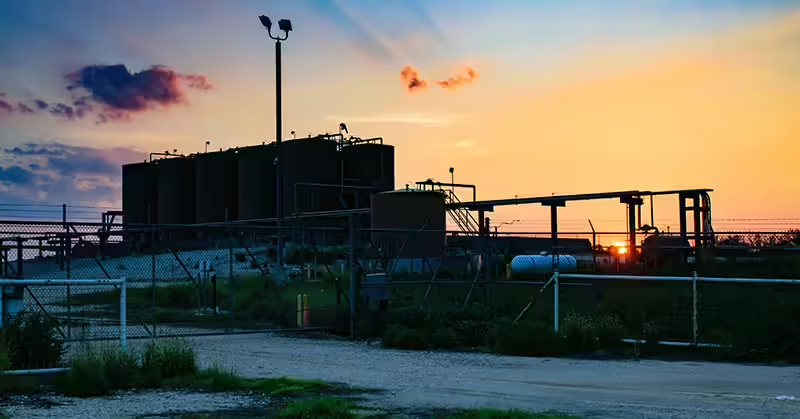New Rules for Oil Tank Batteries in Louisiana
January 23, 2022

Louisiana regulators have established tighter rules for oil field tank batteries after an explosion tragically killed a 14-year-old girl.
State Police investigators believe the young girl frequently hung out on the Urban Oil and Gas tank battery. She was on top of the first tank that exploded on February 28, 2021, throwing her into the air and killing her, a report says.
What is a Tank Battery?
A tank battery is a system consisting of produced water, natural gas, and crude oil storage tanks, connected by pipelines, used to store these products. It is common for some E&P (exploration & production) operators to own and operate multiple production sites within a small geographical area to facilitate easier operations and transport these products. All products produced from the various well sites then travel via pipelines to a centrally-located tank battery location.
See Tank Batteries
What Are the New Rules Regarding Oil Tank Batteries in Louisiana?
U.S. News reports the following about tank batteries and Louisiana’s new rules surrounding oil tank batteries:
Oil tank batteries store oil wells that aren’t connected to major pipelines. They can hold hundreds of thousands of gallons of crude oil and can emit flammable fumes.
The new rules require operators to surround sites with fences at least four feet (1.2 meters) high, with a gate that’s locked when the sites are unattended. Tank hatches have to be securely sealed when unmanned unless they’re part of a pressure relief system, and signs have to note the hazards of the tanks.
These regulations apply to sites within 500 feet (152 meters) of a highway or a home, 1,000 feet (304 meters) of a school or church, or anywhere within the limits of a city, town, or village.
Tank batteries were previously “treated as just another part of a well site,” the Department of Natural Resources said, so they weren’t individually identified. The Office of Conservation is working to make a list of all tank battery sites in Louisiana, which hasn’t been done before.
A 2011 report by the U.S. Chemical Safety and Hazard Investigation Board highlighted the dangers of not having warning signs and fences at storage facilities. It noted that 44 people were killed and 25 were injured in 26 explosions from 1983 to 2010. Further, the Chemical Safety Board made the following findings:
The CSB found the three explosions in Mississippi, Oklahoma, and Texas could have been prevented or made less likely by restricting access to the facilities, by providing warning signage, securing the hatches on the tanks, or utilizing an inherently safer tank design at these facilities. The growing number of oil and gas facilities nationally, their accessibility to members of the public, and the lack of awareness among the public about the hazards posed by the tanks suggest a potential for similar incidents. The CSB makes the following key findings:
- Members of the public, most often children and young adults, commonly visit oil and gas production sites without authorization for recreational purposes.
- Members of the public gain access to production tanks via attached unsecured ladders and catwalks, and may come into contact with flammable vapors from tank vents or unsecured tank hatches.
- Members of the public, unaware of the explosion and fire hazards associated with the tanks, unintentionally introduce ignition sources for the flammable vapor, leading to explosions.
- The CSB identified 26 similar incidents between 1983 and 2010, which resulted in a total of 44 fatalities and 25 injuries. All the victims were 25 years of age or less.
- The three incidents investigated by the CSB in 2009-2010 occurred in isolated, rural wooded areas at production sites that were unfenced, did not have clear or legible warning signs, as required under OSHA’s Hazard Communication Standard, and did not have hatch locks to prevent access to the flammable hydrocarbons inside the tanks.
- The storage tanks did not include inherently safer design features to prevent tank explosions. Safer design features used in the downstream, refining sector would likely prevent tank explosions at E&P sites. These include the use of vents fitted with pressure-vacuum devices, flame arrestors, vapor recovery systems, floating roofs, or an equivalent alternative.
- E&P storage tanks are exempt from the security requirements of the Clean Water Act and from the risk management requirements of the Clean Air Act.
- Industry guidance from the American Petroleum Institute recommends specific security measures for storage tanks of refined petroleum products but not for storage tanks at upstream E&P sites, and the National Fire Protection Association standards do not adequately define security expectations where these deadly incidents occurred.
- Some states, including California and Ohio, and some localities have mandated security (including fencing, locked or sealed tank hatches, and warning signs) for E&P sites, particularly in urban areas. As a result, despite its large role as an oil-producing state with many of these types of facilities, none of the 26 incidents occurred in California. However, many other large oil and gas producing states have no such requirements (except for certain E&P sites where toxic hydrogen sulfide gas is present).
What Recommendations did the Chemical Safety Board Make?
The Chemical Safety Board made a variety of recommendations in 2011 to make storage facilities safe. The recommendations were made to the Environmental Protection Agency, the Mississippi Oil and Gas Board, the Oklahoma Corporation Commission, the Texas Railroad Commission, the American Petroleum Institute, and the National Fire Protection Association. The Chemical Safety Board’s recommendations are as follows:
The Environmental Protection Agency
Publish a safety alert directed to owners and operators of exploration and production facilities with flammable storage tanks, advising them of their general duty clause responsibilities for accident prevention under the Clean Air Act. At a minimum, the safety alert should:
- Warn that storage tanks at unmanned facilities may be subject to tampering or introduction of ignition sources by members of the public, which could result in a tank explosion or other accidental release to the environment
- Recommend the use of inherently safer storage tank design features to reduce the likelihood of explosions, including restrictions on the use of open vents for flammable hydrocarbons, flame arrestors, pressure vacuum vent valves, floating roofs, vapor recovery systems, or an equivalent alternative.
- Describe sufficient security measures to prevent non-employee access to flammable storage tanks, including such measures as a full fence surrounding the tank with a locked gate, hatch locks on tank manways, and barriers securely attached to tank external ladders or stairways
- Recommend that hazard signs or placards be displayed on or near tanks to identify the fire and explosion hazards using words and symbols recognizable by the general public
The Mississippi Oil and Gas Board
Amend state oil and gas regulations to require the use of inherently safer tank design features such as flame arrestors, pressure vacuum vents, floating roofs, vapor recovery systems or an equivalent alternative, to prevent the ignition of a flammable atmosphere inside the tank. Oklahoma Corporation Commission 2011-H-1-R03 Amend state oil and gas regulations to:
- Protect storage tanks at exploration and production sites from public access by requiring sufficient security measures, such as full fencing with a locked gate, hatch locks on tank manways, and barriers securely attached to tank external ladders and stairways.
- Require hazards signs or placards on or near tanks that identify the fire and explosion hazards using words and symbols recognizable by the general public.
- Require the use of inherently safer tank design features such as flame arrestors, pressure vacuum vents, floating roofs, vapor recovery systems, or an equivalent alternative, to prevent the ignition of a flammable atmosphere inside the tank.
The Texas Railroad Commission
Amend state oil and gas regulations to:
- Protect storage tanks at exploration and production sites from public access by requiring sufficient security measures, such as full fencing with a locked gate, hatch locks on tank manways, and barriers securely attached to tank external ladders and stairways.
- Require hazards signs or placards on or near tanks that identify the fire and explosion hazards using words and symbols recognizable to the general public.
- Require the use of inherently safer tank design features such as flame arrestors, pressure vacuum vents, floating roofs, vapor recovery systems, or an equivalent alternative to prevent the ignition of a flammable atmosphere inside the tank.
The American Petroleum Institute
Create a new standard or amend existing standards covering exploration and production facilities to:
- Warn that storage tanks at unmanned facilities may be subject to tampering or introduction of ignition sources by members of the public, which could result in a tank explosion or other accidental release to the environment.
- Recommend the use of inherently safer storage tank design features to reduce the likelihood of explosions, including restrictions on the use of open vents for flammable hydrocarbons, flame arrestors, pressure vacuum vent valves, floating roofs, vapor recovery systems, or an equivalent alternative.
- Require security measures at least as protective as API 2610 to prevent non-employee access to flammable storage tanks at upstream E&P sites, including such measures as a full fence surrounding the tank(s) with a locked gate, hatch locks on tank manways, and barriers securely attached to tank external ladders or stairways.
- Require that hazard signs or placards be displayed on or near tanks to identify the fire and explosion hazards using words and symbols recognizable by the general public.
- Recommend that new or revised mineral leasing agreements include security and signage requirements as described above.
The National Fire Protection Association
Amend NFPA 30, “Storage of Liquids in Tanks—Requirements for all Storage Tanks” as follows:
- Remove the term “isolated” from the current wording of the standard and replace it with a more descriptive term, such as “normally unoccupied”
- Remove the words “Where necessary” from Security for Unsupervised Storage Tanks, Chapter 21.7.2.2. b) Add a reference to a relevant security standard that offers specifications on fencing, locks, and other site security measures.
- Add a definition of security encompassing requirements such as fencing, locked gates, hatch locks, and barriers.
What is the Purpose of the Chemical Safety Board?
The Chemical Safety Board is an independent federal agency charged with investigating industrial chemical accidents. The Chemical Safety Board’s mission is to “drive chemical safety change through independent investigation to protect people and the environment.” The Chemical Safety Board’s vision is “a nation safe from chemical disasters.” Put simply, the Chemical Safety Board investigates chemical accidents, determines a root cause for the accident (if possible), and develops a solution to prevent the accident from reoccurring. The Chemical Safety Board does this to keep workers and communities safe.
What should I do if I was injured by an oil tank battery explosion?
If you were injured or a loved one was killed in an oil tank battery explosion, you should contact an experienced oilfield accident lawyer at Morrow & Sheppard LLP for a free, confidential consultation, after receiving medical care and stabilizing yourself, or by having a trusted family member reach out.
Daniel Sheppard is licensed to practice personal injury law in Texas and Louisiana. Daniel takes pride in providing exceptional service to clients who were seriously hurt on the job and brings his relentless work ethic into the office and the courtroom. Learn more about Daniel.
- Home
- |
- Oilfield Injuries
- |
- New Rules for Oil Tank...
















































